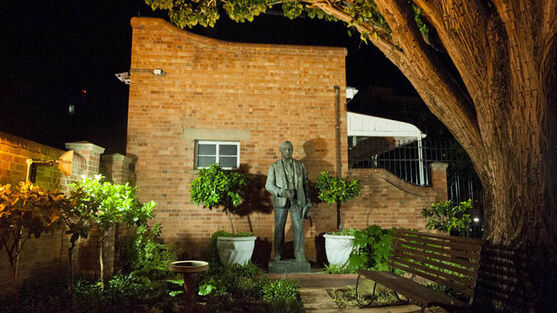Today in Kimberley's History
|
|
|
|
On 16 June 2009, exactly 33 years after the start of the Soweto Uprising in 1976, and 77 years and six days after the statue of Cecil John Rhodes was unveiled and dedicated in Mahikeng in 1932, the same statue was quietly removed from the town made famous by Baden-Powell and brought to Kimberley. The statue was in Mahikeng during the Great Depression, saw out the steam train era, was part of the Apartheid enforced Bantustan Bophutatswana, witnessed at close quarters the racial fighting of the transition to black majority rule in 1994, was daubed (and worse), and had already been moved from the eyes of a public that did not quite see Cecil Rhodes as those in the 1930s had seen the statesman, imperialist and colonialist.
In Kimberley, Rhodes’ statue, the last sculptured by the great John Tweed before he died, was placed in the garden of the world-famous Kimberley Club, the Club he was instrumental in founding in 1881; the same Club where he spent days, nay, weeks, months and years planning not just the amalgamation of the diamond mines, but also the expansion of Great Britain’s Empire northwards into Africa. He will once again gaze northwards, but here in Kimberley where he made his fortune, he will be close to both his homes – the cottage he shared with Dr Jameson just over the road, and the Club itself where over the many years, Rhodes, his friends, colleagues and partners had enjoyed many happy hours of relaxation and contemplation.
Mafeking (now Mahikeng), then aptly described as the Gateway to Rhodesia (now Zimbabwe), was paid a fitting tribute on Friday 10 June 1932 when Sir Herbert Stanley, High Commissioner to South Africa, unveiled a statue of Cecil John Rhodes by the sculptor John Tweed on the Square outside the railway station
Sir Herbert was accompanied to the unveiling by Sir James MacDonald, who was largely responsible for the erection of the statue, Captain Holbech (aide de camp), and the Mayor of Mafeking, Mr WR Galloway. When Sir Herbert arrived outside the railway station, the children present sang the British National Anthem and afterwards he inspected the Guard of Honour, a detachment of Boy Scouts.
The Mayor opened the proceedings by welcoming the visitors. He thanked Sir James Macdonald to whom, he said, Mafeking owed a debt of gratitude for without his benevolence and hard work the statue would not have been erected. Sir Herbert Stanley in his address considered it a privilege to be involved in the unveiling of the statue, "I am also sure that the people of Mafeking are not unmindful of the generosity of those to whom the erection and gift of this statue are due. I will mention only one name, that of my old and dear friend, Sir James Macdonald. We are happy to have him among us today, and would ask him to accept our thanks for this splendid benefaction, and to convey them to his colleagues and fellow contributors."
Sir Herbert unveiled the statue after his address and handed it over to the Mayor and people of Mafeking. The Reverend Mr Wilson then dedicated it. The statue is 8 feet high and was the third sculpture of Rhodes that John Tweed had executed.
On the 27th June 2014 the Mail & Guradian published a story called "The peculiar search for the statue of Cecil 'Gone' Rhodes", click here to read the full article.
In Kimberley, Rhodes’ statue, the last sculptured by the great John Tweed before he died, was placed in the garden of the world-famous Kimberley Club, the Club he was instrumental in founding in 1881; the same Club where he spent days, nay, weeks, months and years planning not just the amalgamation of the diamond mines, but also the expansion of Great Britain’s Empire northwards into Africa. He will once again gaze northwards, but here in Kimberley where he made his fortune, he will be close to both his homes – the cottage he shared with Dr Jameson just over the road, and the Club itself where over the many years, Rhodes, his friends, colleagues and partners had enjoyed many happy hours of relaxation and contemplation.
Mafeking (now Mahikeng), then aptly described as the Gateway to Rhodesia (now Zimbabwe), was paid a fitting tribute on Friday 10 June 1932 when Sir Herbert Stanley, High Commissioner to South Africa, unveiled a statue of Cecil John Rhodes by the sculptor John Tweed on the Square outside the railway station
Sir Herbert was accompanied to the unveiling by Sir James MacDonald, who was largely responsible for the erection of the statue, Captain Holbech (aide de camp), and the Mayor of Mafeking, Mr WR Galloway. When Sir Herbert arrived outside the railway station, the children present sang the British National Anthem and afterwards he inspected the Guard of Honour, a detachment of Boy Scouts.
The Mayor opened the proceedings by welcoming the visitors. He thanked Sir James Macdonald to whom, he said, Mafeking owed a debt of gratitude for without his benevolence and hard work the statue would not have been erected. Sir Herbert Stanley in his address considered it a privilege to be involved in the unveiling of the statue, "I am also sure that the people of Mafeking are not unmindful of the generosity of those to whom the erection and gift of this statue are due. I will mention only one name, that of my old and dear friend, Sir James Macdonald. We are happy to have him among us today, and would ask him to accept our thanks for this splendid benefaction, and to convey them to his colleagues and fellow contributors."
Sir Herbert unveiled the statue after his address and handed it over to the Mayor and people of Mafeking. The Reverend Mr Wilson then dedicated it. The statue is 8 feet high and was the third sculpture of Rhodes that John Tweed had executed.
On the 27th June 2014 the Mail & Guradian published a story called "The peculiar search for the statue of Cecil 'Gone' Rhodes", click here to read the full article.
Primary information source courtesy of Kimberley Calls...and Recalls Facebook Group
Soweto Youth Uprisings - 1976
The June 16 1976 Uprising that began in Soweto and spread countrywide profoundly changed the socio-political landscape in South Africa. Events that triggered the uprising can be traced back to policies of the Apartheid government that resulted in the introduction of the Bantu Education Act in 1953. The rise of the Black Consciousness Movement (BCM) and the formation of South African Students Organisation (SASO) raised the political consciousness of many students while others joined the wave of anti-Apartheid sentiment within the student community. When the language of Afrikaans alongside English was made compulsory as a medium of instruction in schools in 1974, black students began mobilizing themselves.
On 16 June 1976 between 3000 and 10 000 students mobilized by the South African Students Movement's Action Committee supported by the BCM marched peacefully to demonstrate and protest against the government’s directive. The march was meant to culminate at a rally in Orlando Stadium. On their pathway they were met by heavily armed police who fired teargas and later live ammunition on demonstrating students. This resulted in a widespread revolt that turned into an uprising against the government. While the uprising began in Soweto, it spread across the country and carried on until the following year.
The aftermath of the events of June 16 1976 had dire consequences for the Apartheid government. Images of the police firing on peacefully demonstrating students led an international revulsion against South Africa as its brutality was exposed. Meanwhile, the weakened and exiled liberation movements received new recruits fleeing political persecution at home giving impetus to the struggle against Apartheid.
(Source: SAHistory.org.za)
The June 16 1976 Uprising that began in Soweto and spread countrywide profoundly changed the socio-political landscape in South Africa. Events that triggered the uprising can be traced back to policies of the Apartheid government that resulted in the introduction of the Bantu Education Act in 1953. The rise of the Black Consciousness Movement (BCM) and the formation of South African Students Organisation (SASO) raised the political consciousness of many students while others joined the wave of anti-Apartheid sentiment within the student community. When the language of Afrikaans alongside English was made compulsory as a medium of instruction in schools in 1974, black students began mobilizing themselves.
On 16 June 1976 between 3000 and 10 000 students mobilized by the South African Students Movement's Action Committee supported by the BCM marched peacefully to demonstrate and protest against the government’s directive. The march was meant to culminate at a rally in Orlando Stadium. On their pathway they were met by heavily armed police who fired teargas and later live ammunition on demonstrating students. This resulted in a widespread revolt that turned into an uprising against the government. While the uprising began in Soweto, it spread across the country and carried on until the following year.
The aftermath of the events of June 16 1976 had dire consequences for the Apartheid government. Images of the police firing on peacefully demonstrating students led an international revulsion against South Africa as its brutality was exposed. Meanwhile, the weakened and exiled liberation movements received new recruits fleeing political persecution at home giving impetus to the struggle against Apartheid.
(Source: SAHistory.org.za)

